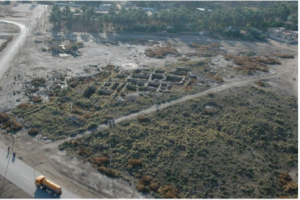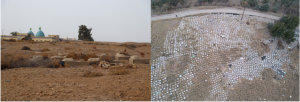Jumjuma, the Skull Village in Babylon
By Zainab, on 30 November 2022
Written by Ammar Al-Taee
Jumjuma is a village located inside the archaeological site of Babylon, to the southwest of the remains of the Temple of Marduk, on the eastern bank of the present-day Shatt al-Hilla (a branch of the Euphrates River). The village’s name derives from the Arabic word for ‘skull’, الجُمْجُمَة.
After the fall of Babylon, Jumjuma was occupied for centuries, with archaeological evidence supporting habitation as far back as the Hellenistic and Parthian periods. We know that it was the headquarters of European excavation missions in the late Ottoman Period. Claudius Rich, in his book Narrative of a Journey to the Site of Babylon, published in 1811, said, “North of Hilla on the river is the Jumjuma, which is the burial place of the Sultan.” Also H.V. Hilprecht said in his 1904 book, The Excavations in Assyria and Babylonia, “in the company of two regiments of soldiers, who happened to leave for Hilla, the French expedition quitted Baghdad, established its headquarters at Jumjuma, and began actual excavations at the palace of Nebuchadnezzar II on July 15, 1852.”
But what about the skull name? The majority of Jumjuma residents believe that the name appeared after the battle of Nahrawan that took place between the army of Imam Ali and the army of Abdullah Al-Rasbi in 659 AD. Imam Ali and his followers were returning to Kufa and passed through Babylon. His son (Omer), or as the locals call him, Amran, succumbed to his wounds suffered during the battle and needed to be laid to rest. So, to mark his son’s death, Imam Ali asked one of the skulls he found in the area about the location’s name; the skull became animated and answered, “IT IS BABYLON”. The event stuck, and the contemporary village became ‘Skull,’ as Imam Ali buried his son on top of the archaeological mounds northeast of the settlement.
Other local people believed that the name Jumjuma dates to before Imam Ali because the village was originally an ancient cemetery. It makes sense because some villagers still find graves amongst the Babylonian brick walls, pottery, and other artifacts when constructing sewers for homes or plowing for agriculture. Their finds inspired the only excavations in the area carried out by The Iraqi State Board of Antiquities and Heritage (SBAH) in 2002, near the village’s primary school (Figure 1). Archaeologists discovered a massive building dating back to the Seleucid era and a big cemetery. In one of these rooms, they found a jar containing 146 silver coins with the image of Alexander the Great. It is not rare in this village, as German architect Robert Koldewey found a statue of a boy whose fragments were found in the southern city wall about 500 meters east of the skull village in 1913 and 1914, assembled as the final form of a Hellenistic statue exhibited today in the Pergamum Museum in Berlin (Figure 2).

Figure 1: aerial photo of excavations at Jumjuma (credit: John Russell 2004)

Figure 2: fragmentary terracotta statue of a boy, Hellenistic period, now in Pergamon Museum, Berlin (credit: Ehab Raad Abbas 2019)
The area around Jumjuma is still used as a cemetery, and some believe that the reason for the continuation of the burial in this village is because it is an inherited habit. It may be one of the oldest cemeteries in Mesopotamia, where burial has continued from ancient times until now. Many graves can be seen in old pictures and the modern pictures, all the way up to the vicinity of Amran Ibn Ali, which has become a symbol of the village (Figures 3 and 4).

Figure 3: Jumjuma cemetery with shrine of Amran Ibn Ali on the horizon (credit: Ammar Al-Taee 2022)
Figure 4: drone footages of the cemetery at Jumjuma (credit: Ammar Al-Taee 2022)
Some residents in Jumjuma and other surrounding villages stand against the recent changes made at Amran ibn-Ali’s tomb, a pattern of destruction similar to many Islamic heritage shrines in Iraq’s archaeological sites. For example, Amran’s tomb near Jumjuma sits above the Babylonian temple dedicated to Marduk, arguably the ancient city’s most sacred and essential site (Figure 5). The historic repurposing of Babylon goes along with an evolutional sense of its importance throughout history. However, the recent demolition of Amran’s early Ottoman-era tomb complex to construct a new, more prominent modern shrine came at the expense of an important part of that long story that is now lost forever (Figure 6). Many stories, legends and oral traditions carried by the local population were associated with the tomb.

Figure 5: The shrine of Amran Ibn Ali in the early 20th century (credit: Robert Koldewey 1914)
Figure 6: The shrine of Amran Ibn Ali today (credit: Ammar Al-Taee 2022)
Early Islamic sites, like Amran’s tomb, form important parts of the evolutional history of reuse and reoccupation of ancient sacred sites. Since the fall of authoritarian government controls, many modern-era shrines have been created or replace far older sacred sites, often early-era shrine structures superimposed over ancient Neo-Babylonian temple remains. These constructions take place in archaeological zones, where encroachment is restricted by law.
The resurgence of religious pilgrimage tourism and its aggressive pursuit to construct new shrines at the expense of older, high-value historical layers is a concern. These impositions are highly destructive to earlier era, post-ancient Islamic religious heritage, and worse, install irreversible and compromising complexes over ancient sacred site archaeology, limiting future opportunities for scientific study and the enjoyment of Iraqis and their future generations.
 Close
Close


